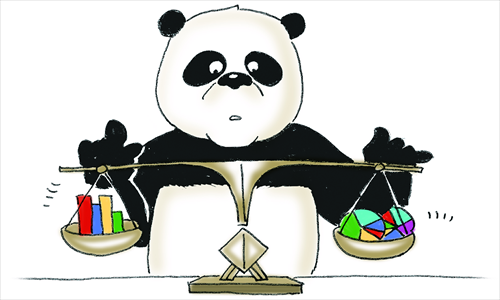Five-Year Plan tackles rebalancing issues

Illustration: Liu Rui/GT
The fifth plenum of the 18th CPC Central Committee came at a critical juncture for China. Facing serious challenges at home and abroad, the nation's leadership endorsed a draft of the long-awaited 13th Five-Year Plan - China's strategic roadmap that will frame its economic and social priorities over the 2016-20 period.
The implications for the Chinese economy are especially important. The good news is that the plenum took special aim on the missing piece of China's rebalancing puzzle; the behavioral norms of fearful and uncertain Chinese families. This is an important and unequivocal step in the right direction.
There is really nothing all that new in the over-arching economic goals of the new plan. The communiqué refers elliptically to China's objectives to stay the course of "medium-high economic growth." It took follow-up speeches by the senior leadership, initially by Premier Li Keqiang and then by President Xi Jinping, to translate that into a GDP growth target of around 6.5 percent over the next five years.
This is basically the growth answer that "solves" China's long-standing promise to double per capita incomes over the 2010 to 2020 time frame. Unsurprisingly, this represents a modest slowdown from the original 7 percent target of the 12th Five-Year Plan. However with actual growth over the past five years likely to average about 7.8 percent, about 10 percent faster than planned, the downshift to 6.5 percent may feel a bit more abrupt.
The stress on services- and consumer-led rebalancing in the plan does not mean that China is ignoring its traditional sources of powerful economic growth. The fifth plenum makes repeated references to a more sophisticated and innovative manufacturing sector, stressing new features of higher-value added industrial development. All this is very much in keeping with the Chinese leadership's long-emphasized innovation-based strategy that it correctly believes is essential to avoid the dreaded "middle-income trap."
But there is an area of focus in the new 13th Five-Year Plan that breaks from the recent past - a willingness to up the ante on the social safety net as a catalytic force in turbo-charging consumer-led rebalancing. The 12th Five-Year Plan pushed ahead on two aspects of this daunting structural transformation. These were services-led development, which provided a powerful impetus to job creation, and urbanization, which offered significant income leverage for those moving from rural communities to cities.
While this strategy was important in boosting the personal income share and altering the industrial structure of the Chinese economy, it was not effective moving the needle on private consumption. Services are now more than 51 percent of Chinese GDP, up markedly from the 44 percent share at the onset of the 12th Five-Year Plan in 2011, but the private consumption share has only inched up to 37 percent from 35 percent over the same time period.
The disconnect between solid growth in services and labor income generation, juxtaposed against minimal growth in discretionary consumption, stems largely from understandable fears of an uncertain and insecure future which continue to grip Chinese families.
As a result, newfound income continues to be skewed more toward saving rather than spending; the saving rate of urban households exceeded 30 percent in 2014, up significantly from the 24 percent rate a decade earlier.
In framing the broad outlines of the new 13th Five-Year Plan, the just concluded fifth plenum appears to take dead aim on this key constraint. Endorsing universal enrollment in retirement and critical illness healthcare plans, in particular, consolidating existing plans that are currently bifurcated into urban and rural schemes, are important new steps in that direction. The same is true of the related willingness to deploy State capital to fund such initiatives - in this case underscoring earlier announcements to raise taxes on State-owned enterprises (from 15 percent to 30 percent by 2020) to support expansion of China's national social security fund.
Equally important is a new emphasis on targeting increases in hukou-based urbanization - in essence, providing portability to the social welfare benefits of China's some 270 million migrant workers.
Currently, while around 55 percent of the Chinese population live and work in urban areas, only about 36 percent of the people actually receive social benefits in their places of residency. The only way to close that gap and address the insecurity of migrant workers is by pushing ahead on hukou reform - a vital piece to China's safety net imperative. The 13th Five-Year Plan is premised on just such a step.
All in all, the fifth plenum, in conjunction with the 13th Five-Year Plan that it foreshadows, focuses on the most important missing pieces in China's strategic rebalancing: the fear and insecurity that have prevented Chinese families from playing a more active role in what the leadership has long called a moderately prosperous society. Only by addressing the safety net imperatives of retirement and healthcare, along with a greater emphasis on benefit portability that comes with heightened hukou reform, can excessive fear-driven precautionary saving be converted into discretionary consumption.
The author is a faculty member at Yale University and former chairman of Morgan Stanley Asia. He is the author of Unbalanced: The Codependency of America and China (2014). opinion@globaltimes.com.cn